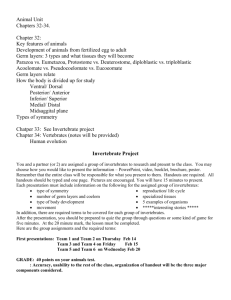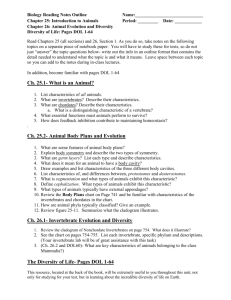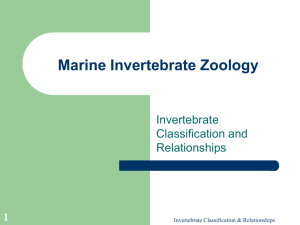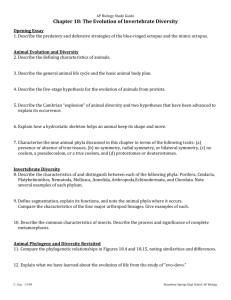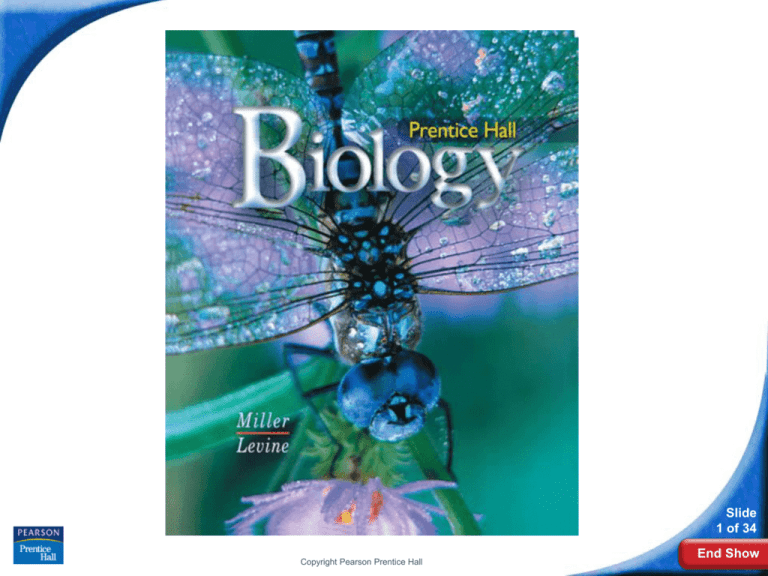
Biology
Slide
1 of 34
Copyright Pearson Prentice Hall
End Show
29–1 Invertebrate Evolution
Slide
2 of 34
Copyright Pearson Prentice Hall
End Show
29–1 Invertebrate Evolution
Origin of Invertebrates
Origin of Invertebrates
Invertebrate fossils, dating between 575 and 543
million years ago, were discovered in the Ediacara
Hills of Australia and in Chengjiang, China.
The Ediacaran fossils include some of the earliest
and most primitive animals known.
Slide
3 of 34
Copyright Pearson Prentice Hall
End Show
29–1 Invertebrate Evolution
Origin of Invertebrates
The fossils:
• were flat and plate shaped
• were segmented
• had bilateral symmetry
• lived on the bottom of shallow seas
• were made of soft tissues
• absorbed nutrients from the surrounding water
Slide
4 of 34
Copyright Pearson Prentice Hall
End Show
29–1 Invertebrate Evolution
Origin of Invertebrates
Some of these animals may have had photosynthetic
algae living within their bodies.
Some may have been related to soft-bodied
invertebrates.
They were probably simple and had little internal
specialization.
Slide
5 of 34
Copyright Pearson Prentice Hall
End Show
29–1 Invertebrate Evolution
Origin of Invertebrates
Beginnings of Invertebrate Diversity
By the Cambrian Period, 544 million years ago,
some animals had evolved shells, skeletons, and
other hard body parts.
One of the best-known sites of Cambrian fossils is
the Burgess Shale of Canada.
Slide
6 of 34
Copyright Pearson Prentice Hall
End Show
29–1 Invertebrate Evolution
Origin of Invertebrates
By the Cambrian period, animals had acquired
specialized cells, tissues, and organs.
During that time, the ancestors of most modern
animal phyla first appeared in the fossil record.
Slide
7 of 34
Copyright Pearson Prentice Hall
End Show
29–1 Invertebrate Evolution
Origin of Invertebrates
The animals of the Burgess Shale had many of the
characteristics of modern day invertebrates including:
•
•
•
•
•
body symmetry
segmentation
a skeleton
a front and a back end
appendages adapted for many functions
Slide
8 of 34
Copyright Pearson Prentice Hall
End Show
29–1 Invertebrate Evolution
Invertebrate Phylogeny
Invertebrate Phylogeny
Many features of modern invertebrates evolved
during the Cambrian period such as:
• tissues and organs
• patterns of early development
• body symmetry
• cephalization
• segmentation
• formation of three germ layers and a coelom
Copyright Pearson Prentice Hall
Slide
9 of 34
End Show
29–1 Invertebrate Evolution
Invertebrate Phylogeny
Invertebrate Evolutionary Relationships
Slide
10 of 34
Copyright Pearson Prentice Hall
End Show
29–1 Invertebrate Evolution
Invertebrate Phylogeny
Roundworms
Flatworms
Cnidarians
Sponges
Unicellular ancestor
Copyright Pearson Prentice Hall
Slide
11 of 34
End Show
29–1 Invertebrate Evolution
Invertebrate Phylogeny
Slide
12 of 34
Copyright Pearson Prentice Hall
End Show
29–1 Invertebrate Evolution
Invertebrate Phylogeny
Slide
13 of 34
Copyright Pearson Prentice Hall
End Show
29–1 Invertebrate Evolution
Invertebrate Phylogeny
What are the major trends in invertebrate
evolution?
Slide
14 of 34
Copyright Pearson Prentice Hall
End Show
29–1 Invertebrate Evolution
Evolutionary Trends
Evolutionary Trends
The appearance of each phylum in the fossil record
represents the evolution of a successful and unique
body plan.
Features of this body plan typically change over
time, leading to the formation of many new traits.
Slide
15 of 34
Copyright Pearson Prentice Hall
End Show
29–1 Invertebrate Evolution
Evolutionary Trends
Slide
16 of 34
Copyright Pearson Prentice Hall
End Show
29–1 Invertebrate Evolution
Evolutionary Trends
Slide
17 of 34
Copyright Pearson Prentice Hall
End Show
29–1 Invertebrate Evolution
Evolutionary Trends
Specialized Cells, Tissues, and Organs
As larger and more complex animals evolved,
specialized cells joined together to form tissues,
organs, and organ systems that work together to
carry out complex functions.
Flatworms have simple organs for digestion,
excretion, response, and reproduction.
More complex animals, such as mollusks and
arthropods, have organ systems.
Slide
18 of 34
Copyright Pearson Prentice Hall
End Show
29–1 Invertebrate Evolution
Evolutionary Trends
Body Symmetry
All invertebrates, except sponges, exhibit
some type of body symmetry.
Slide
19 of 34
Copyright Pearson Prentice Hall
End Show
29–1 Invertebrate Evolution
Evolutionary Trends
Cnidarians and echinoderms exhibit radial
symmetry where parts extend from the center of
the body.
Radial symmetry
Planes of
symmetry
Copyright Pearson Prentice Hall
Slide
20 of 34
End Show
29–1 Invertebrate Evolution
Evolutionary Trends
Worms, mollusks, and arthropods exhibit bilateral
symmetry, or have mirror-image left and right
sides.
Bilateral symmetry
Slide
21 of 34
Copyright Pearson Prentice Hall
End Show
29–1 Invertebrate Evolution
Evolutionary Trends
Cephalization
Cephalization is the concentration of sense
organs and nerve cells in the front of the body.
Invertebrates with cephalization can
respond to the environment in more
sophisticated ways than can simpler
invertebrates.
Slide
22 of 34
Copyright Pearson Prentice Hall
End Show
29–1 Invertebrate Evolution
Evolutionary Trends
In most worms and arthropods, nerve cells are
arranged in structures called ganglia.
In more complex invertebrates, nerve cells form an
organ called a brain.
Slide
23 of 34
Copyright Pearson Prentice Hall
End Show
29–1 Invertebrate Evolution
Evolutionary Trends
Segmentation
Over the course of evolution, different segments in
invertebrates have often become specialized for
specific functions.
Segmentation allows an animal to increase its size
with minimal new genetic material.
Slide
24 of 34
Copyright Pearson Prentice Hall
End Show
29–1 Invertebrate Evolution
Evolutionary Trends
Coelom Formation
Flatworms are acoelomates. This means they have
no coelom, or body cavity, that forms between the
germ layers.
Ectoderm
Mesoderm
Endoderm
Digestive
cavity
Acoelomate
Copyright Pearson Prentice Hall
Slide
25 of 34
End Show
29–1 Invertebrate Evolution
Evolutionary Trends
Pseudocoelomates have a body cavity lined partially
with mesoderm.
Pseudocoelom
Digestive tract
Pseudocoelomate
Copyright Pearson Prentice Hall
Slide
26 of 34
End Show
29–1 Invertebrate Evolution
Evolutionary Trends
Most complex animal phyla have a true
coelom that is lined completely with tissue
derived from mesoderm.
Coelom
Digestive tract
Coelomate
Copyright Pearson Prentice Hall
Slide
27 of 34
End Show
29–1 Invertebrate Evolution
Evolutionary Trends
Embryological Development
In most invertebrates, the zygote divides to form a
blastula—a hollow ball of cells.
In protostomes, the blastopore, or the opening of
the blastula, develops into a mouth.
In deuterostomes, the blastopore forms an anus.
Slide
28 of 34
Copyright Pearson Prentice Hall
End Show
29–1
Click to Launch:
Continue to:
- or -
Slide
29 of 34
End Show
Copyright Pearson Prentice Hall
29–1
According to the most recent studies of animal fossils,
which of the following is correct?
a. Annelids with a true coelom appeared before
cnidarians with two germ layers.
b. Radial symmetry appears in cnidarians and adult
echinoderms.
c. Protostome development appears after
deuterostome development.
d. Bilateral symmetry appears before tissues.
Slide
30 of 34
End Show
Copyright Pearson Prentice Hall
29–1
Acoelomates lack
a. tissues.
b. a coelom.
c. radial symmetry.
d. specialized cells.
Slide
31 of 34
End Show
Copyright Pearson Prentice Hall
29–1
Worms, mollusks, and arthropods exhibit
a. bilateral symmetry.
b. radial symmetry.
c. no internal specialization.
d. similar larval forms.
Slide
32 of 34
End Show
Copyright Pearson Prentice Hall
29–1
In most invertebrates, the zygote divides
repeatedly to form a
a. coelom.
b. digestive tract.
c. blastula.
d. mesoderm.
Slide
33 of 34
End Show
Copyright Pearson Prentice Hall
29–1
The animal group that has no germ layers, body
symmetry, cephalization, or coelom is the
a. flatworms.
b. annelids.
c. sponges.
d. cnidarians.
Slide
34 of 34
End Show
Copyright Pearson Prentice Hall
END OF SECTION


